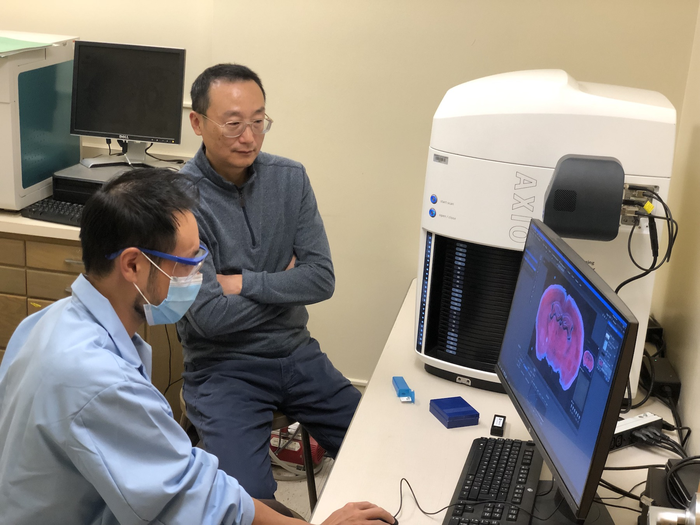Two University of Wyoming researchers decided to pick each other’s brain, so to speak. Specifically, they examined the importance of the frontal cortex, the portion of the brain used in decision-making, expressive language and voluntary movement.

Credit: Zhaojie Zhang
Two University of Wyoming researchers decided to pick each other’s brain, so to speak. Specifically, they examined the importance of the frontal cortex, the portion of the brain used in decision-making, expressive language and voluntary movement.
And the two scientists learned that a recurrent neural network structure, or RNN, is responsible for those functions.
“This RNN receives inputs from emotional regions of the brain and sends outputs to the motor cortex, the part of the brain responsible for voluntary movement,” says Qian-Quan Sun, a UW professor of zoology and physiology. “In the artificial intelligence field, computer scientists have designed various artificial neural networks, including RNNs, which effectively solve problems, such as language translation and object recognition, by simulating the neural network in the mammalian brain.
“This paper provides a basic structure of neural networks in the mammalian brain. This basic structure will guide us in investigating behavioral strategy,” Sun continues. “After more details are acquired, we may translate it to an artificial neural network, using it to solve real-world problems.”
Sun, director of UW’s Wyoming Sensory Biology Center of Biomedical Research Excellence, is the lead author of a paper titled “A Long-Range Recurrent Neuronal Network Linking the Emotion Regions with Somatic Motor Cortex” that was published today (Tuesday) in Cell Reports. The open-access journal publishes peer-reviewed papers across the entire life sciences spectrum that report new biological insight.
The first author of the paper is Yihan Wang, a Ph.D. student in UW’s Doctoral Neuroscience Program, from Beijing, China. The research was funded by grants from the National Institutes of Health.
Artificial RNNs are important deep-learning algorithms that are commonly used for ordinal or temporal lobe problems, such as language translation, natural language processing, speech recognition and image captioning, Sun says. An RNN recognizes sequential characteristics in data and uses patterns to predict the next likely scenario. RNNs are incorporated into popular applications such as Siri, Google Voice Search and Google Translate.
“The biggest surprise is that RNNs not only exist in our brain, but they are constructed with much more delicate function and, yet, highly efficient in processing sequential inputs,” Sun says. “In general, cortical neurons are spatially reciprocal and intermingle with each other. However, Wang’s data not only showed that the RNN does exist in the most important part of the brain — the frontal cortex — but additionally, this network is less complex than we thought and mostly unidirectional. This is a big surprise to us, because this tells us that this network may be in charge of unique functions when compared with others.”
Sun and Wang analyzed the brains of mice for the lab research. Different genetically modified mouse strains provided the two with the ability to label specific types of neurons with fluorescent proteins that follow the brain’s connections — and to monitor the activities of specific neurons with intrinsically fluorescent markers.
The research has many real-world implications, according to Sun.
“One, now that we know of this important building block, the work will help further decipher how our brain makes decisions,” he says. “Two, it will help uncover other similar RNNs in other parts of the brain. It will help researchers use computational simulations to predict how our brain codes short-term memory, and how can it be used. And three, specifically for this study, it will help us understand how emotions, such as fear and anxiety, regulate our movements.”
Both the content and research approach used by Sun and Wang should have very broad interests with artificial intelligence researchers, biologists, computational modelers and neuroscientists, Sun says.
“The precise connection map also may help us understand the cause of the neurological and psychiatric disorders where there are problems with the regulation of emotions or voluntary movement,” Sun says. “However, before this finding can have wider applications, there are lots of details — such as how the local inhibitory network refined the RNN, and how different components underlie specific emotion states — that still need to be figured out.”
Wang’s goal is to work out these details in his dissertation work, Sun says.
Journal
Cell Reports
DOI
10.1016/j.celrep.2021.109733
Method of Research
Observational study
Subject of Research
Animals
Article Title
A Long-Range Recurrent Neuronal Network Linking the Emotion Regions with Somatic Motor Cortex
Article Publication Date
21-Sep-2021




